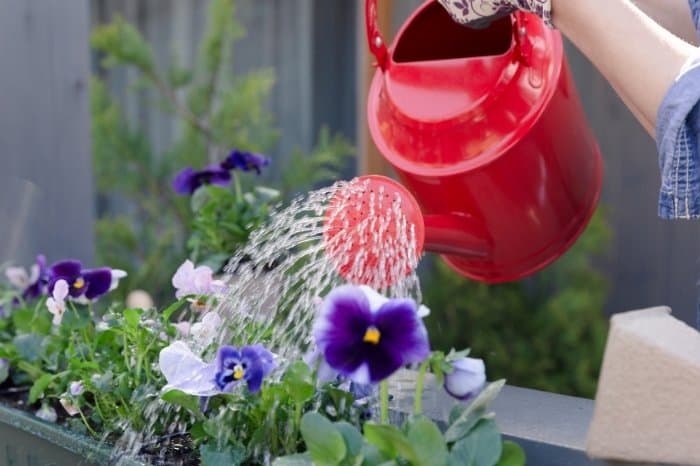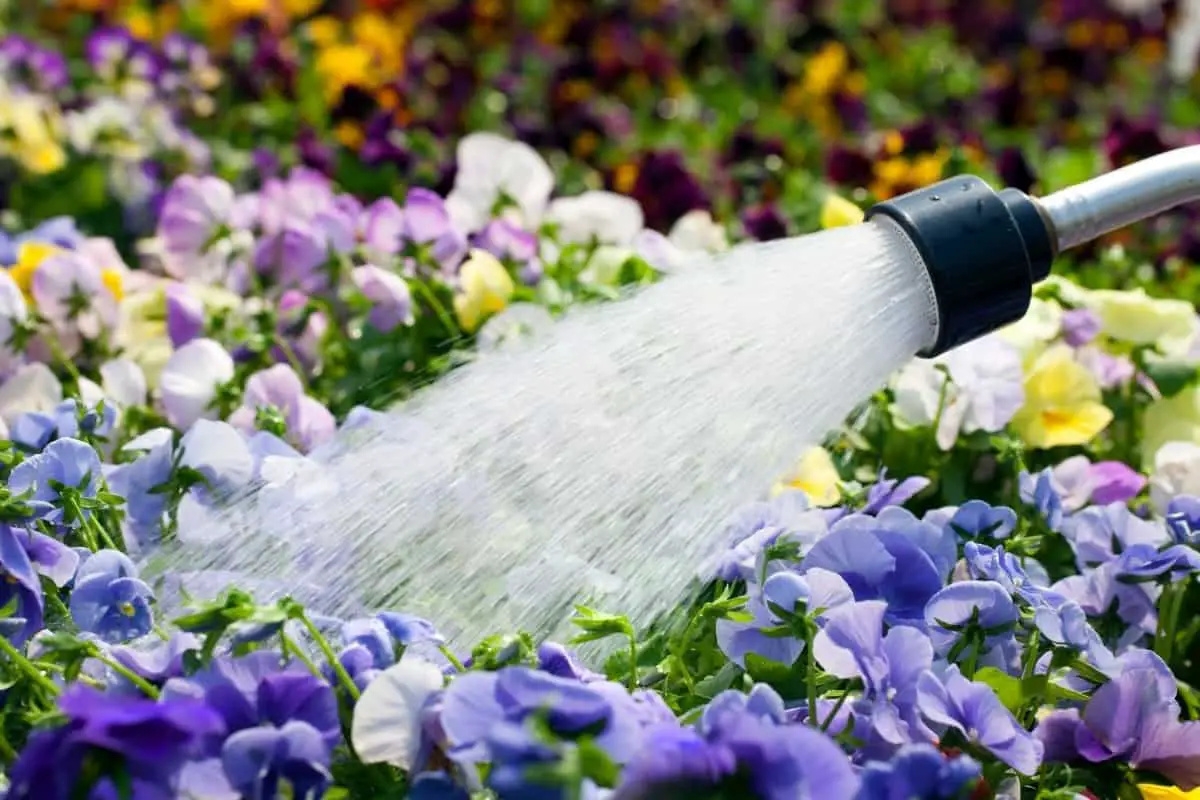Last Updated on September 30, 2023 by Griselda M.
So you got yourself some beautiful pansies flowers? One question that bothers gardeners is how often to water pansies; let’s look at it here.
Growing pansies is not for the fainthearted since they require high maintenance. Pansy flowers are short-lived, adorable biennial plants, fitting perfectly into your windowsill or front door entrance.
They are beautiful hybrids that flower in multicolor and come in many shades. However, you must learn to take good care of these beauties to keep them bright, vibrant, and thriving!
Let’s uncover how to take care of these flowers, including how often to water them.
How Often To Water Your Pansies
Pansies flowers require an inch of water each per week to keep them growing actively growing and healthy.
However, be cautious as you water because excess water causes Edema in pansies. Edema is a condition whereby the soil is excessively soggy, making the roots unable to breathe.
Roots need to breathe and absorb the oxygen requirements from the air spaces inside the soil. If the soil gets waterlogged, they won’t be able to breathe.

Most pansy gardeners’ unsuccessful attempts are because their flowers suffer from Edema. This is a result of too much watering!
Avoid making this mistake by looking for Edema signs that include stunted growth, discoloration, drying leaves, or wilting. If your pansy plant lacks enough oxygen or nutrients, it means your plant is dying.
Bottom line, if you forget everything else, don’t forget your pansies need only 1 inch of water each week. However, this depends on the weather; if it’s too hot, you might have to water once or twice a day if your plants are under direct sunlight or at a windy location.
How Do You Water Your Pansies?
When growing your pansies, you must ensure the water supply they get is through the right watering method. The overhead technique is the best way to water these flowers.
If you are watering them manually using a watering can or irrigation system, ensure the water is directly channeled to the soil.
The overhead watering technique helps fight fungal rot diseases that are more prone to happen.
However, on a serious note, this method of watering helps to avoid fungal rot diseases. Fungal rot is caused by stagnant water on leaves and flowers. It also spreads through the water and wind, with these pathogens taking root in stagnant waters inside the spaces between plants. This is harmful to pansies and destroys most of them.
Taking Care Of Your Pansies
Soil
Pansies prefer well-drained soils that are not too dry or too soggy. You have to ensure that your pansies have moist and rich soils. To ensure your soil has the right amount of moisture, touch the soil with your fingers. The soil should be moist to the touch, and your pansies will rejoice at this. If the soil is dry to the touch, you might need to water them. Your soil must remain moist at all times because once it dries, it’s tough to get it properly moist again. It’s tough to get potting soil to absorb water again, and your pansies by this point are likely to be already dehydrated. To prevent this from happening, ensure you water your pansies appropriately.
Transplanting
If you transfer your pansies from one container to another or your garden, you will need to handle these with care. Water your transferred pansies immediately and generously to help their roots begin to form. Transferring pansies is strenuous to their roots, but watering them adequately will help them adapt to the new environment quickly. Do not transplant your pansies in the rainy season and think the rain will be enough. Always water them by yourself. Rainfall is harsh on the fragile roots and can wash away the top layers of the soil. Transfer your pansies when the weather is not rainy to help them cope well. However, if it rains after you transfer the plants, don’t be afraid. Keep an eye on the amount of water the rain provides, and if it’s enough, don’t water the plants. Wait until the soil is a bit dry.
Mulching
Adding a 2 or 3-inch layer of organic mulch-like pine needles around the pansies is ideal for preserving the soil’s moisture. Do not press the mulch to prevent fungal spores from splashing onto your pansies. Use your mulch sparingly; too much will hold excess moisture and cause more trouble than help your soil.
USA Pine Straw – Premium Pine Needle Mulch – Covers 300 Sqft
Fertilizing
Most likely, your soil won’t have all the nutrients your pansies need, so you will need to provide them through fertilizers. You can do so by using fish emulsion or any other water-soluble fertilizer when watering. Fertilizing your pansies will help the pansies grow healthy green foliage and produce lots of flowers! To keep your pansies producing more flowers, remove any spent ones. This will keep them producing flowers for months.
Once the flowering season ends, you can still keep your pansies alive by watering them periodically. If you keep them in good conditions, they will bloom again in the fall, something you will definitely love.
Conclusion
We know that taking care of your pansies is a hassle, but the beauty of this flower outweighs the hassle. Watering is one of the most important things you will need to do for your pansies.
Now that you know how often to water pansies and do it perfectly, you have just the right knowledge to grow your own.
If you are looking to grow pansies from scratch, buying an already grown plant from a local nursery is much easier than growing your own from seeds. Pansies are delicate and require too much care, especially for germinating seeds and the tender stages of the plant.
Getting a grown plant from the nursery will get you flowers a lot sooner. We hope this information helps you in your pansies growing journey.
Keep the watering not too much or too little, just the right amount, and you will be a happy soul! And your pansies will thrive as a reward for your hard work.
FAQs
Do pansies need water everyday?
Pansies are a very popular houseplant in the US. They are not only easy to grow but also quite attractive. If you have one at home, you probably know that they need a lot of water. Most plants have a daily need for water but what about pansies? Can they survive without water for long? Well, according to some experts, yes they can!
But the experts also say that they should not be watered every day. This is especially true if they have been left in a pot for a while. So, if you want to grow pansies in your home or office, you need to find out if they can survive without water for a few days. If they do, then you can keep watering them for a week or two only. After that, you will need to stop watering them.
Do pansies like sun or shade?
They can be grown in both conditions. Pansies are very hardy and do well in full sun. They don't like it to be too hot, but they can take a bit of rain. They will be fine if you water them every other day. You can also grow them in containers. They like warm days and cool nights.
What is the best time to plant pansies?
Pansies are planted in spring. They will grow quickly in the early spring and summer. They do best when temperatures are mild, so they are best planted in early spring and summer.
Pansies have a very long bloom season, usually from April to November. If you have a large garden, you can plant pansies throughout the year to extend their bloom season.
How long do pansy flowers last?
Pansies look best when planted in full sun. They do not need fertilizer or water. You can buy pansies from your local nursery or you can start them indoors and transplant them outside when weather conditions are right.
Can pansies survive indoors?
Pansies are very adaptable and will thrive indoors in warm areas.
How cold can pansies survive?
Pansies are easy to grow, but are they able to survive in the cold temperatures of the Arctic Circle? The most important thing for a pansy to be able to do is to flower. The flowers that the pansies produce are the ones that attract pollinators such as butterflies and bees. However, if the pansies are growing in an environment where it gets very cold, they may not bloom. They could just die.
FAQs
Do pansies need water everyday?
Pansies are a very popular houseplant in the US. They are not only easy to grow but also quite attractive. If you have one at home, you probably know that they need a lot of water. Most plants have a daily need for water but what about pansies? Can they survive without water for long? Well, according to some experts, yes they can!
But the experts also say that they should not be watered every day. This is especially true if they have been left in a pot for a while. So, if you want to grow pansies in your home or office, you need to find out if they can survive without water for a few days. If they do, then you can keep watering them for a week or two only. After that, you will need to stop watering them.
Do pansies like sun or shade?
They can be grown in both conditions. Pansies are very hardy and do well in full sun. They don't like it to be too hot, but they can take a bit of rain. They will be fine if you water them every other day. You can also grow them in containers. They like warm days and cool nights.
What is the best time to plant pansies?
Pansies are planted in spring. They will grow quickly in the early spring and summer. They do best when temperatures are mild, so they are best planted in early spring and summer.
Pansies have a very long bloom season, usually from April to November. If you have a large garden, you can plant pansies throughout the year to extend their bloom season.
How long do pansy flowers last?
Pansies look best when planted in full sun. They do not need fertilizer or water. You can buy pansies from your local nursery or you can start them indoors and transplant them outside when weather conditions are right.
Can pansies survive indoors?
Pansies are very adaptable and will thrive indoors in warm areas.
How cold can pansies survive?
Pansies are easy to grow, but are they able to survive in the cold temperatures of the Arctic Circle? The most important thing for a pansy to be able to do is to flower. The flowers that the pansies produce are the ones that attract pollinators such as butterflies and bees. However, if the pansies are growing in an environment where it gets very cold, they may not bloom. They could just die.
Caroline is a gardener who loves to get down to the nitty–gritty of gardening. She proudly proclaims herself as a ‘dirt worshipper‘ and can often be found deep in the garden, covered in soil and singing to her plants. As a self–proclaimed ‘plant whisperer‘, Caroline believes that plants need love and attention just like any other living thing, and she loves to give them both. When she‘s not tending to her garden, you can often find her researching the latest gardening trends, or teaching others how to make their gardens thrive



